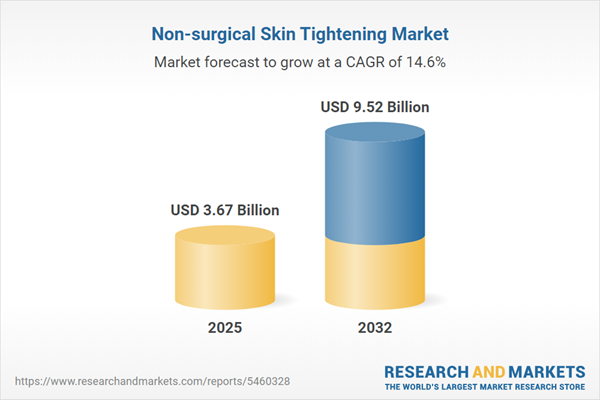Speak directly to the analyst to clarify any post sales queries you may have.
Senior decision-makers face a swiftly evolving non-surgical skin tightening market driven by technology innovation, changing regulations, and rising patient standards. Forward-looking organizations rely on market intelligence to make informed decisions, strengthen strategies, and capture value across the global aesthetics landscape.
Market Snapshot: Non-Surgical Skin Tightening Market
The non-surgical skin tightening market is experiencing consistent growth, reaching a global value of USD 3.19 billion in 2024. The sector is projected for expansion to USD 3.67 billion by 2025 and an estimated USD 9.52 billion by 2032. This momentum comes from a significant rise in demand for treatments offering minimal invasiveness and high efficacy. Advances in device technology facilitate seamless integration into clinical workflows, while collaborative efforts among key market players help shape best practices. The digital transformation of healthcare, alongside a shift toward patient-centered care, is redefining operational models and enabling providers to manage dynamic patient needs with greater agility.
Scope & Segmentation Overview
- Technology Platforms: Energy-based devices, including diode and erbium lasers, radiofrequency, infrared, and ultrasound, drive ongoing enhancement in clinical applications as well as outcomes for both providers and patients.
- Application Areas: Solutions address a wide spectrum of anatomical zones—such as face, neck, chin, cheeks, forehead, abdomen, arms, thighs, and buttocks—serving cosmetic improvements and select therapeutic objectives.
- End Users: Dermatology clinics, hospitals, medical spas, and home-care channels form the primary access points, ensuring broad reach and helping organizations fulfill the diverse preferences of end users.
- Distribution Channels: Traditional in-person distribution via clinics and hospitals is now complemented by digital platforms that allow providers to engage patients more efficiently and adapt to new modes of care delivery.
- Geographic Reach: The non-surgical skin tightening market spans key regions, including the Americas, Europe, Middle East & Africa, and Asia-Pacific. Mature healthcare environments in North America support sustained adoption, while Asia-Pacific’s rapid urbanization and consumer trends drive distinct service and strategy adaptation.
- Key Companies: Sector benchmarks are set by organizations such as Merz Pharma GmbH & Co. KGaA, Candela Corporation, Lumenis Ltd., Cutera Inc., Cynosure LLC, Sisram Medical Ltd., InMode Ltd., Venus Concept Ltd., BTL Industries Inc., and Lutronic Corporation, collectively paving the way for ongoing quality and innovation.
Key Takeaways for Senior Decision-Makers
- Adopting multi-modality devices allows organizations to improve treatment flexibility and broaden their patient base, enabling more tailored solutions for a variety of needs.
- The trend toward home-use systems is transforming service models, encouraging greater patient initiative and supporting increased autonomy in treatment management.
- Collaboration among manufacturers, clinicians, and regulators enhances technology uptake and supports compliance, which is critical as the regulatory landscape evolves.
- Regional strategies should build on established healthcare infrastructure where present while remaining responsive to new entrants and regulatory changes in growth markets.
- Enhancing technical features remains central, promoting higher efficiency and supporting consistent experiences across all clinical and non-clinical environments.
Tariff Impact and Supply Chain Adaptation
Current US tariffs on imported components require non-surgical skin tightening providers to pivot their supply chain strategies. Organizations are responding with increased domestic sourcing, nearshoring options, and by refining inventory systems to prevent distribution interruptions and reliably serve both established and emerging markets.
Methodology & Data Sources
This report integrates insights from executive interviews, reviews of global regulatory frameworks, and comprehensive analysis of trade data. Leveraging proven market research methodologies, the findings are specifically designed for the operational and strategic needs of stakeholders in the minimally invasive aesthetics sector.
Why This Report Matters
- Guides procurement optimization, supports regulatory compliance, and informs the creation of patient-centric service models for the non-surgical skin tightening sector.
- Offers a foundation for risk management and process enhancement while supporting forward-looking investment strategies.
- Equips leaders with actionable insights to navigate market evolution and maintain operational competitiveness.
Conclusion
This analysis enables senior leaders to strengthen operational resilience, align with emerging trends, and differentiate through ongoing innovation and disciplined market practice.
Additional Product Information:
- Purchase of this report includes 1 year online access with quarterly updates.
- This report can be updated on request. Please contact our Customer Experience team using the Ask a Question widget on our website.
Table of Contents
3. Executive Summary
4. Market Overview
7. Cumulative Impact of Artificial Intelligence 2025
Companies Mentioned
The companies profiled in this Non-surgical Skin Tightening market report include:- Merz Pharma GmbH & Co. KGaA
- Candela Corporation
- Lumenis Ltd.
- Cutera, Inc.
- Cynosure, LLC
- Sisram Medical Ltd.
- InMode Ltd.
- Venus Concept Ltd.
- BTL Industries, Inc.
- Lutronic Corporation
Table Information
| Report Attribute | Details |
|---|---|
| No. of Pages | 199 |
| Published | October 2025 |
| Forecast Period | 2025 - 2032 |
| Estimated Market Value ( USD | $ 3.67 Billion |
| Forecasted Market Value ( USD | $ 9.52 Billion |
| Compound Annual Growth Rate | 14.6% |
| Regions Covered | Global |
| No. of Companies Mentioned | 11 |









